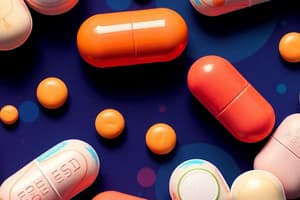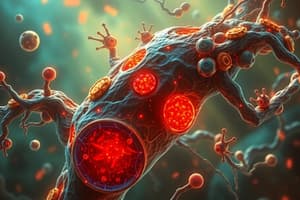Podcast
Questions and Answers
What is inflammation?
What is inflammation?
Inflammation is a normal, protective response to tissue injury caused by physical trauma, toxic chemicals, or microbiologic agents. It is the body's effort to inactivate or destroy invading organisms, remove irritants, and set the stage for tissue repair.
Inappropriate activation of the immune system can result in:
Inappropriate activation of the immune system can result in:
- Inflammation and immune-mediated diseases such as rheumatoid arthritis (RA) (correct)
- Increased quality of life
- Reduced inflammation
- Decreased pain
What is the main action of NSAIDs?
What is the main action of NSAIDs?
NSAIDs act primarily by inhibiting the cyclooxygenase (COX) enzymes that catalyse the first step in prostanoid biosynthesis, leading to decreased prostaglandin synthesis.
Aspirin is commonly used as an anti-inflammatory medication.
Aspirin is commonly used as an anti-inflammatory medication.
What are the three major therapeutic actions of NSAIDs, including aspirin?
What are the three major therapeutic actions of NSAIDs, including aspirin?
NSAIDs arrest the progression of arthritis and induce remission.
NSAIDs arrest the progression of arthritis and induce remission.
What is the effect of NSAIDs on body temperature?
What is the effect of NSAIDs on body temperature?
In what age group should aspirin be avoided due to the risk of Reye syndrome?
In what age group should aspirin be avoided due to the risk of Reye syndrome?
What is the effect of aspirin on platelets?
What is the effect of aspirin on platelets?
What is a common topical use of salicylic acid?
What is a common topical use of salicylic acid?
What is a potential effect of NSAIDs on uric acid excretion?
What is a potential effect of NSAIDs on uric acid excretion?
What is the most common adverse effect of NSAIDs?
What is the most common adverse effect of NSAIDs?
NSAIDs should always be taken on an empty stomach for best absorption.
NSAIDs should always be taken on an empty stomach for best absorption.
Why is aspirin often withheld before surgery?
Why is aspirin often withheld before surgery?
The use of NSAIDs in patients with a history of heart failure or kidney disease puts them at high risk for what?
The use of NSAIDs in patients with a history of heart failure or kidney disease puts them at high risk for what?
All NSAIDs carry a boxed warning regarding the increased risk for...
All NSAIDs carry a boxed warning regarding the increased risk for...
What is a symptom of mild salicylate toxicity (salicylism)?
What is a symptom of mild salicylate toxicity (salicylism)?
NSAIDs are safe to use during the third trimester of pregnancy.
NSAIDs are safe to use during the third trimester of pregnancy.
Give an advantage of Celecoxib over other NSAIDs
Give an advantage of Celecoxib over other NSAIDs
Unlike the inhibition of COX-1 by aspirin, is the inhibition of COX-2 by celecoxib reversible?
Unlike the inhibition of COX-1 by aspirin, is the inhibition of COX-2 by celecoxib reversible?
What is the half life of celecoxib?
What is the half life of celecoxib?
Acetaminophen is considered an NSAID.
Acetaminophen is considered an NSAID.
Why is acetaminophen the analgesic/antipyretic of choice for children?
Why is acetaminophen the analgesic/antipyretic of choice for children?
What is an antidote to acetaminophen overdose?
What is an antidote to acetaminophen overdose?
Flashcards
Inflammation
Inflammation
Protective response to tissue injury, triggered by trauma, toxins, or microbes, to neutralize threats and initiate repair.
NSAIDs
NSAIDs
A group of drugs with antipyretic, analgesic, and anti-inflammatory properties that work by inhibiting cyclooxygenase (COX) enzymes.
Cyclooxygenase (COX)
Cyclooxygenase (COX)
Enzymes (COX-1 and COX-2) that catalyze the first step in prostanoid biosynthesis; NSAIDs inhibit these enzymes.
COX-2 Inhibition
COX-2 Inhibition
Signup and view all the flashcards
Aspirin's Mechanism
Aspirin's Mechanism
Signup and view all the flashcards
NSAIDs' Three Major Actions
NSAIDs' Three Major Actions
Signup and view all the flashcards
Antipyretic Action
Antipyretic Action
Signup and view all the flashcards
Aspirin's Cardiovascular Application
Aspirin's Cardiovascular Application
Signup and view all the flashcards
Platelet Inhibition Duration (Aspirin)
Platelet Inhibition Duration (Aspirin)
Signup and view all the flashcards
Salicylates' Pharmacokinetics
Salicylates' Pharmacokinetics
Signup and view all the flashcards
NSAIDs' Gastrointestinal Effects
NSAIDs' Gastrointestinal Effects
Signup and view all the flashcards
NSAIDs Antiplatelet Effect
NSAIDs Antiplatelet Effect
Signup and view all the flashcards
NSAIDs Renal Effects
NSAIDs Renal Effects
Signup and view all the flashcards
COX-2 Selective Agents: Cardiac Effects
COX-2 Selective Agents: Cardiac Effects
Signup and view all the flashcards
NSAIDs and Asthma
NSAIDs and Asthma
Signup and view all the flashcards
Salicylate Protein Binding Displacement
Salicylate Protein Binding Displacement
Signup and view all the flashcards
Salicylism
Salicylism
Signup and view all the flashcards
NSAIDs in Third Trimester
NSAIDs in Third Trimester
Signup and view all the flashcards
Celecoxib Mechanism
Celecoxib Mechanism
Signup and view all the flashcards
Celecoxib Metabolism
Celecoxib Metabolism
Signup and view all the flashcards
Acetaminophen Use in Children
Acetaminophen Use in Children
Signup and view all the flashcards
Acetaminophen Mechanism
Acetaminophen Mechanism
Signup and view all the flashcards
Acetaminophen Metabolism
Acetaminophen Metabolism
Signup and view all the flashcards
NAPQI
NAPQI
Signup and view all the flashcards
Glutathione's Role
Glutathione's Role
Signup and view all the flashcards
Acetaminophen Overdose Antidote
Acetaminophen Overdose Antidote
Signup and view all the flashcards
NSAIDs and Arthritis
NSAIDs and Arthritis
Signup and view all the flashcards
NSAIDs uses
NSAIDs uses
Signup and view all the flashcards
Aspirin and Children
Aspirin and Children
Signup and view all the flashcards
Production of prostacyclin (PGI2)
Production of prostacyclin (PGI2)
Signup and view all the flashcards
Study Notes
- Inflammation is a protective response to tissue injury from trauma, chemicals, or microbes.
- The body uses inflammation to inactivate organisms, remove irritants, and prepare for tissue repair.
- Inflammation subsides when healing is complete, but inappropriate immune activation causes diseases like rheumatoid arthritis (RA).
- RA can lead to joint damage, disability, pain, and reduced quality of life.
- RA pharmacotherapy uses anti-inflammatory and immunosuppressive agents to reduce inflammation, pain, and slow disease progression.
Nonsteroidal Anti-inflammatory Drugs (NSAIDs)
- NSAIDs are chemically different agents with antipyretic, analgesic, and anti-inflammatory properties.
- NSAIDs include derivatives of salicylic acid (aspirin), propionic acid (ibuprofen, fenoprofen, flurbiprofen, ketoprofen, naproxen), acetic acid (diclofenac, etodolac, indomethacin, tolmetin), enolic acid (meloxicam, piroxicam), fenamates (mefenamic acid), and the selective COX-2 inhibitor (celecoxib).
- They inhibit cyclooxygenase (COX) enzymes, reducing prostaglandin synthesis.
- NSAID safety and efficacy depend on COX-1 or COX-2 enzyme selectivity.
- COX-2 inhibition leads to anti-inflammatory and analgesic effects.
- COX-1 inhibition can prevent cardiovascular events but also causes adverse effects.
Aspirin and Other NSAIDs
- Aspirin is rarely used as an anti-inflammatory due to needed high doses.
- Aspirin is utilized at low doses to prevent cardiovascular events like stroke and myocardial infarction (MI).
- Aspirin is an irreversible COX inhibitor, unlike other NSAIDs.
Mechanism of Action
- Aspirin irreversibly inactivates COX, while other NSAIDs are reversible inhibitors.
- NSAIDs have anti-inflammatory, analgesic, and antipyretic effects, but effectiveness varies.
- Anti-inflammatory actions: NSAIDs decrease prostaglandin formation, modulating inflammation.
- Analgesic action: NSAIDs decrease PGE2 synthesis, reducing pain sensation; COX-2 inhibition is responsible for this activity.
- Antipyretic action: NSAIDs lower body temperature in feverish patients by impeding PGE2 synthesis, increasing heat dissipation through vasodilation and sweating, but have no effect on normal body temperature.
Therapeutic Uses
- Anti-inflammatory and Analgesic Uses: NSAIDs treat RA and conditions needing analgesia, like headaches and muscle pain.
- Combining NSAIDs with opioids can treat malignancy pain, lead to an opioid-sparing effect and salicylate exhibits analgesic activity at lower doses.
- For example, two 325-mg aspirin tablets administered four times daily produce analgesia, whereas 12 to 20 tablets per day produce both analgesic and anti-inflammatory activity.
- Antipyretic Uses: Aspirin, ibuprofen, and naproxen can treat fever, however, avoid aspirin in patients under 19 with viral infections (chickenpox, influenza) due to the risk of Reye syndrome.
- Cardiovascular Applications: Aspirin inhibits COX-1-mediated TXA2 production, reducing vasoconstriction, platelet aggregation, and cardiovascular event risk.
- Low-dose aspirin (75-162 mg) is a prophylactic to reduce recurrent cardiovascular events.
- External Applications: Salicylic acid treats acne, methyl salicylate is a cutaneous counterirritant, and diclofenac is topical for osteoarthritis.
Pharmacokinetics of Aspirin and Other NSAIDs
- Most salicylates cross the BBB and placenta and are absorbed through the skin.
- Salicylate is secreted in urine and affects uric acid excretion; avoid aspirin in gout.
- Most NSAIDs are well absorbed, highly protein-bound, and metabolized in the liver to inactive metabolites; excretion is via urine.
Adverse Events
-
Use NSAIDs at the lowest effective dose for the shortest time due to adverse effects.
-
Gastrointestinal: common adverse effects include dyspepsia to bleeding.
-
Production of prostacyclin (PGI2) inhibits gastric acid secretion, and PGE2 and PGF2a stimulate mucus synthesis.
-
COX-1 inhibitors reduce beneficial PGs, increasing gastric acid secretion and GI bleeding.
-
Agents with COX-1 selectivity increase GI event risk, take NSAIDs with food to diminish GI upset.
-
Increased Risk of Bleeding (Antiplatelet Effect): Aspirin inhibits COX-1-mediated TXA2 formation and reduces platelet aggregation for 3-7 days.
-
Platelet aggregation is the first step in thrombus formation, and antiplatelet effect results in prolonged bleeding time.
-
Withhold aspirin for at least 1 week before surgery; NSAIDs other than aspirin are not utilized for their antiplatelet effect but can still prolong bleeding time.
-
Concomitant NSAIDs and aspirin can prevent aspirin from binding to COX, avoid NSAIDs if possible.
-
Renal Effects: NSAIDs prevent PGE2 and PGI2 synthesis, causing sodium and water retention and edema.
-
Patients with heart failure or kidney disease are at high risk.
-
NSAIDs can decrease antihypertensive medication effects and cause acute kidney injury in susceptible patients.
-
Cardiac Effects: Aspirin has cardiovascular protection due to reduced TXA2 production; higher COX-2 selectivity increases cardiovascular event risk.
-
All NSAIDs have boxed warnings for increased cardiovascular risk; avoid in patients with established cardiovascular disease.
-
Naproxen may be the least harmful if NSAIDs are needed.
-
Other Adverse Effects: NSAIDs inhibit PG synthesis but not leukotrienes, use with caution in asthma patients, inhibit prostaglandin synthesis can cause a shift toward leukotriene production and increase the risk of asthma exacerbations.
-
CNS adverse events, such as headache and dizziness, may occur.
-
Approximately 15% of patients taking aspirin experience hypersensitivity reactions.
-
Severe allergy patients should avoid aspirin. including urticaria, bronchoconstriction, and angioedema.
-
Drug Interactions: Salicylate is 80-90% protein bound and can be displaced, increasing free salicylate levels.
-
Aspirin can displace other protein-bound drugs, e.g., warfarin or phenytoin, increasing their levels.
-
Toxicity: Mild salicylate toxicity (salicylism) causes nausea, vomiting, hyperventilation, headache, confusion, and dizziness.
-
Large salicylate doses cause restlessness, hallucinations, convulsions, coma, acidosis, and respiratory failure; 10 g can be fatal in children.
-
Pregnancy: Only use NSAIDs if benefits outweigh risks; avoid in the third trimester due to the risk of premature closure of the ductus arteriosus.
Celecoxib
- A selective COX-2 inhibitor is more selective for COX-2 than COX-1 inhibition and the inhibition of COX-2 is reversible.
Therapeutic uses
- Treats RA and pain with similar efficacy to NSAIDs.
Pharmacokinetics
- Readily absorbed orally, metabolized in the liver, excreted in feces and urine.
- Has a half-life of about 11 hours; can be dosed once or twice daily.
- Reduce dosage with moderate hepatic impairment; avoid in patients with severe hepatic or renal disease.
Adverse effects
- Common effects include headache, dyspepsia, diarrhea, and abdominal pain.
- It is associated with less GI bleeding and dyspepsia than other NSAIDs, but this benefit is lost when aspirin is added.
- Patients at high risk of ulcers needing aspirin should avoid celecoxib but has a similar risk for cardiovascular events.
- Patients with anaphylactoid reactions to aspirin or nonselective NSAIDs may be at risk for similar effects.
Acetaminophen
- It inhibits PG synthesis in the CNS, leading to antipyretic and analgesic effects.
- It has less COX effect in peripheral tissues due to peripheral inactivation, so it is considered as having weak anti-inflammatory activity.
- It does not affect platelet function or increase bleeding time and is not considered an NSAID.
Therapeutic uses
- Treats fever and relieves pain.
- It is a choice for children with viral infections or chickenpox, due to Reye syndrome risk with aspirin.
Pharmacokinetics
- Rapidly absorbed and undergoes first-pass metabolism.
- It is conjugated in the liver to form inactive metabolites.
- A portion is hydroxylated to NAPQI, a reactive metabolite that reacts with sulfhydryl groups and causes liver damage; acetaminophen and its metabolites is excreted in urine.
Adverse effects
- Few adverse effects at normal doses, however, large doses deplete glutathione, and NAPQI reacts with hepatic proteins, resulting in hepatic necrosis.
- Patients with hepatic disease, viral hepatitis, or a history of alcoholism is at higher risk of acetaminophen-induced hepatotoxicity.
- N-acetylcysteine is an antidote in cases of overdose and should be avoided with severe hepatic impairment.
Studying That Suits You
Use AI to generate personalized quizzes and flashcards to suit your learning preferences.




